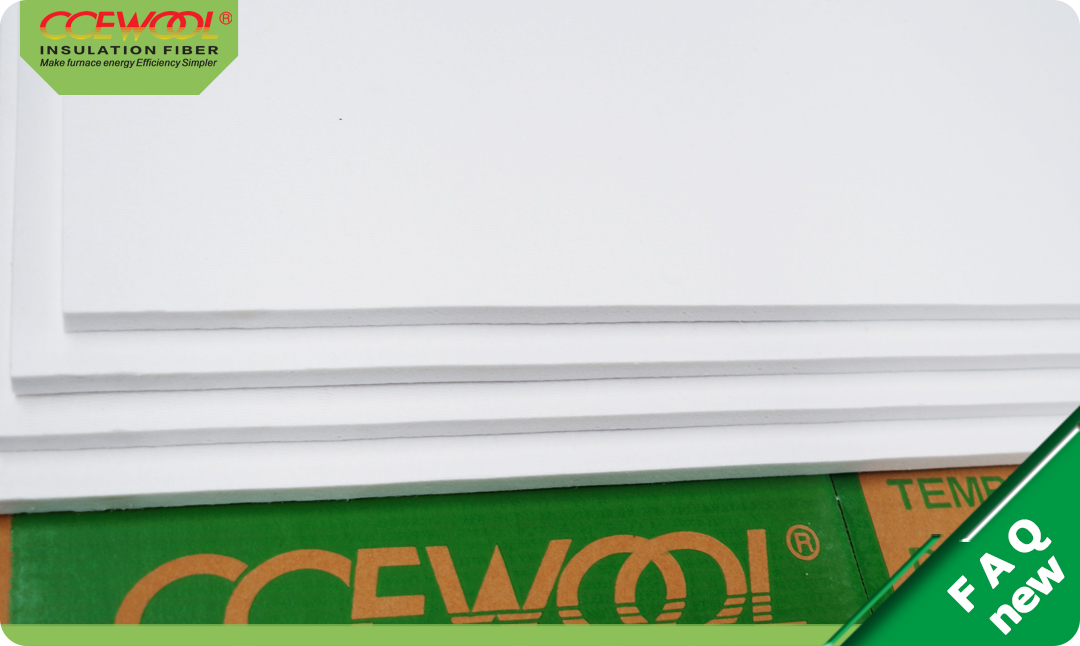In industrial high-temperature protection, people often ask: “Is ceramic fiber board really fireproof?”The answer is yes. However, what truly determines its fire resistance is not the shape of the board, but its fiber structure and material composition.In high-temperature equipment and fire protection systems, fire resistance means more than being “non-combustible.” It’s about slowing heat transfer and protecting structural integrity under extreme conditions.With this core capability, CCEWOOL® ceramic fiber board has become a trusted fire-resistant and thermal insulation material in a wide range of industrial thermal systems.
The Core of Fire Resistance: Fibers as Barriers, Not Fuel
Traditional boards tend to carbonize, deform, or even melt under high temperatures.In contrast, CCEWOOL® ceramic fiber board is made from high-purity alumina (Al₂O₃) and silica (SiO₂)—two inorganic oxides that remain extremely stable in air and do not decompose or release combustible substances even at temperatures above 1200°C.By strictly controlling the impurity content (≤1%), CCEWOOL® effectively prevents grain coarsening and fiber degradation.This ensures that the product maintains a low linear shrinkage rate (<2%), without powdering or collapsing, even after long exposure to high temperatures.
Key Structure: From Flame Retardancy to True Thermal Shielding
CCEWOOL® ceramic fiber board is not a solid plate—it consists of millions of interwoven fibers only 3–5 μm in diameter.This network structure dramatically extends the heat transfer path, weakening and dispersing heat flow as it travels through the material.Produced using imported high-speed centrifuges (11,000 r/min), the fibers are fine and uniform, with a shot content below 15%, which directly reduces thermal conductivity.The fewer the shot particles, the fewer the heat bridges, resulting in better insulation.At 800°C, the thermal conductivity of CCEWOOL® ceramic fiber board is only 0.112 W/m·K, much lower than that of traditional calcium silicate boards or diatomite bricks.Even under direct flame, the front surface temperature rises quickly, but the back surface remains cool, effectively blocking heat transmission.
Engineering Reliability: Manufacturing Determines Stability
Fire performance depends not only on the materials themselves but also on production consistency and structural integrity.CCEWOOL® ceramic fiber board is manufactured through fully automated vacuum forming and high-temperature curing, combined with an intelligent drying system that completes deep dehydration within just two hours.This ensures even fiber distribution, uniform density, and stable moisture content—preventing delamination or cracking under heat.Each board achieves compressive and flexural strength above 0.5 MPa, remaining intact during cutting and installation.Dimensional tolerances are controlled within ±0.5 mm, ensuring tight joints, uniform heating, and minimizing thermal stress concentration that could reduce fire resistance.
Smart Manufacturing: Consistent Fire Performance Through Data Intelligence
The exceptional and consistent fire performance of CCEWOOL® ceramic fiber board is made possible by the company’s self-developed software system:
“Big Data–Driven Refractory Fiber Process Parameter Optimization System V1.0.”This intelligent system continuously monitors and optimizes key parameters such as melting temperature, forming pressure, vacuum drying time, and density matching.By dynamically adjusting raw material ratios and curing curves, it ensures that boards of different thicknesses and densities maintain consistent fire resistance and structural stability.Whether under long-term heat exposure or sudden flame impact, each CCEWOOL® board delivers the same reliable performance.
Engineering Insight: The Essence of Fire Protection Is Time
In steel plants, heat treatment furnaces, chemical facilities, and building firewalls, the essence of fire protection is not just preventing ignition—it’s about delaying heat transfer and buying critical time for cooling, maintenance, or evacuation.
CCEWOOL® ceramic fiber board is well known for this “time barrier” effect:
-
It maintains structural stability under continuous flame exposure.
-
It significantly slows heat penetration, reducing equipment damage.
-
It provides safer thermal insulation for high-temperature and energy systems.
Thus, it is widely used in:
-
Industrial furnace hot-face linings and furnace door fire seals
-
Battery compartments and electrical cabinets as fire partitions
-
Building firewalls and fire door cores
Conclusion: Fireproof by Nature, Not by Design
The fire resistance of ceramic fiber board does not come from being designed as a fireproof material, but from its intrinsic composition and fiber-based structure, which make it a naturally non-combustible thermal barrier.
With its high-purity raw materials and intelligent manufacturing technology, CCEWOOL® ceramic fiber board neither burns nor deforms under flame.In every situation where safety and time are critical, it stands as the most reliable line of fire protection.
Post time: Oct-29-2025


